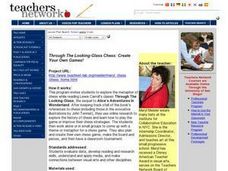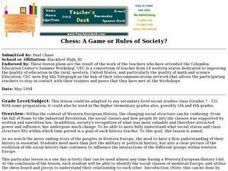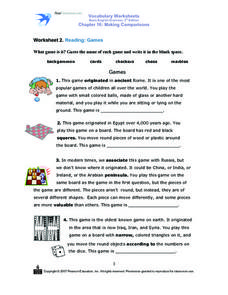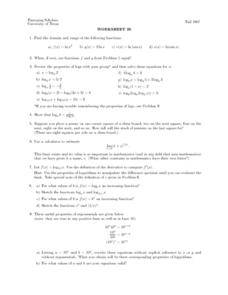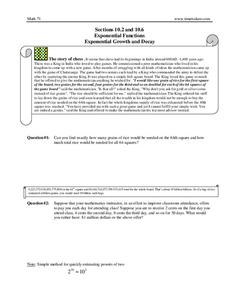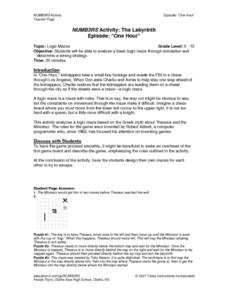Curated OER
Chess Math
Students review angles. In this geometry lesson, students become chess players on a floor chess board. When they make a move, they need to identify the angle of their movement. In the lesson plan it says the "degree" of the angle,...
Curated OER
How is Chess Played?
Young scholars discover how to play chess. In this how is chess played instructional activity, students examine the rules, vocabulary, and tactics of the game of chess.
Curated OER
Chess Lesson Plans
Students discover the game of chess. In this critical thinking instructional activity, students learn the rules for each chess piece and the game as a whole. Students use critical thinking, problem solving, logic, and reasoning skills to...
Ahisma Summer Institute
The Power of One - Math in a Different Angle
In this 2-day lesson focused on exponents, middle schoolers will cross the curriculum by engaging in science, history and language arts activities. Exponential growth will be explored using grains of rice on a chess board. Exponential...
Curated OER
Through the Looking-Glass Chess: Create Your Own Games!
Sixth graders research chess in relation to the metaphors in Lewis Carroll's Through the Looking-Glass. They read the novel and note references to chess and research the history of chess and how to play the game. In groups, they create...
Curated OER
Chess: A Game or Rules of Society
Students identify the social classes of medieval Europe, and utilize the chess board and pieces to explain their relationship to each other.
Curated OER
Check Mate
Students share opinions about the goals and strategies of the games they play. They investigate the World Chess Championship by reading and discussion the article "In Major League of Chess, Next Year Comes So Soon." Students study the...
Missouri Department of Elementary
Tic Tac Toe, Get Off My Toes
Why is conflict resolution such an important skill to learn? Pupils explore the topic, playing an adapted Tic-tac-toe game. Two class teams are tasked with finding a win-win solution to a hypothetical conflict before adding their X or O...
Curated OER
The Chess Problem
In this secondary mathematics worksheet, students solve a problem in which pieces must be places on a chess board so that no three are in line. The one page worksheet contains one problem. The problem has numerous solutions, but two...
Curated OER
Joining Sentences
Sentence combining meets multiple objectives for writers, and they are all available in this informational text exercise. Learners read a mixed-up excerpt about the history of chess, putting 15 sentences into logical order. Have a...
Curated OER
Reading: Games
In this games worksheet, students read the names of 5 common games. Students then read 5 paragraphs that describe the origin of a game. Students guess the name of each game and write it in the blank space.
Curated OER
Mum's Kitchen Floor
Students discuss patterns on a chess board examining symmetries. They read the problem and then brainstorm for ways to solve the problem. As they complete the floor pattern, they record symmetries that it contains.
Curated OER
Exponential Growth Introduced
Students study exponential growth in problems using chess boards and grains of rice. In this exponential growth instructional activity, students watch a video about a chess wager and complete an exponential growth worksheet. Students...
Curated OER
To Infinity: A Numbers Game
Students explore number values by participating in a class game. In this number sense lesson, students utilize dice, cards, and chess pieces to move their piece closer to the end of a number line, the point of infinity. Students answer...
Curated OER
Worksheet 26 - Functions & Logarithms
In this function and logarithms worksheet, students find the domain and range of functions, use the properties of logs to solve equations. This one-page worksheet contains nine multi-step problems.
Curated OER
Comparing Two Stories
Compare new and old versions of the classic story Alice in Wonderland in this comprehensive worksheet packet. Learners read an excerpt from the original, answering several analysis questions. They do the same for a more modern version,...
Curated OER
Does Negative Space Have A Shape?
Students observe negative space in drawing. In this negative space lesson plan, students discover that sketches include negative space or background. Students produce a drawing while paying attention to the negative space.
Mt. San Antonio Collage
Exponential Growth and Decay
Start with the basics and move up the exponential ladder to master a variety of problem-solving and application problems. The problems are heavy on exponential growth and decay, compound interest, and natural log.
Curated OER
Worksheet 3: Vocabulary Review
As a short review of vocabulary, this 10 question activity is a good way to have learners practice words rich in meaning. This worksheet would be appropriate for upper elementary and any older ESL student.
Curated OER
States and Mates
Discuss and reflect on the concept of allies and alliances. The class examines the competition between the United States and Venezuela. Using the New York Times, they search for examples of geopolitical alliances. In addition, they write...
Pearson
Articles: Indefinite
When do you use a or an before a noun? What about the? Learn about indefinite and definite articles with a brief grammar presentation, which focuses on using context clues to determine proper article usage.
EngageNY
End-of-Module Assessment Task: Grade 6 Math Module 2
Give learners a chance to shine. The last installment of a 21-part series is an end-of-module assessment. Scholars show their understanding of operations with decimals and division of fractions by solving problems in the context of a...
Curated OER
The Labyrinth
Students analyze a basic logic maze based on the Greek myth about Theseus and the Minotaur. Through simulation they determine a winning strategy. At the conclusion of the activity, they design their own mazes for each other to try to...
Curated OER
Using Nouns and Pronouns
For this use of nouns and pronouns worksheet, students complete short paragraphs using the correct form of the words in the word banks. They fill the blanks with nouns or pronouns.






